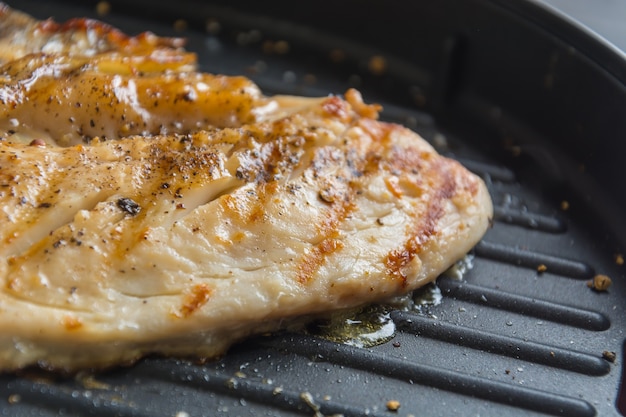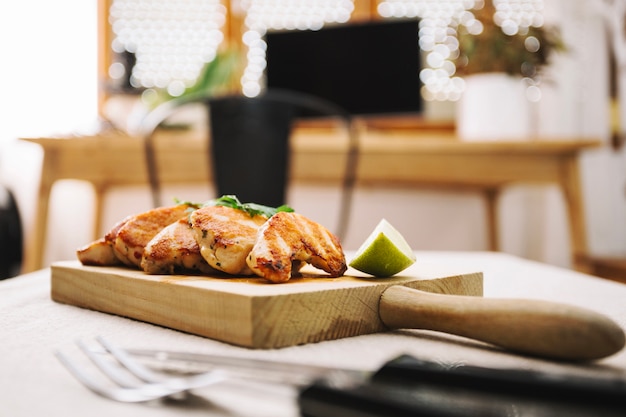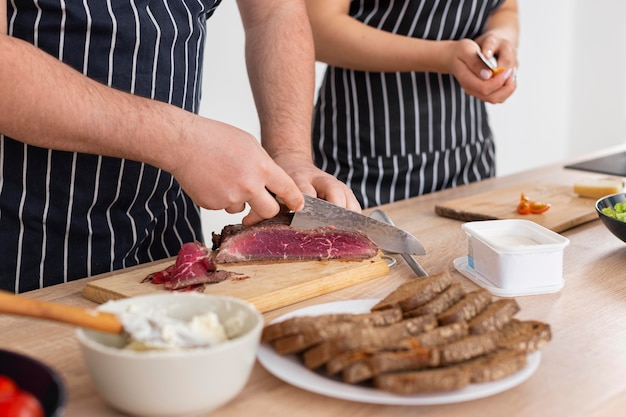There’s something incredibly satisfying about a perfectly cooked pork chop. Juicy, tender, and bursting with flavor, it’s a dish that never fails to please. For years, I’ve been refining my own oven-baked pork chop recipe, striving for that perfect balance of crispiness and tenderness. While I've tried countless methods, I've found that oven-baking reigns supreme when it comes to achieving consistently delicious results. And when it comes to thick cuts, the key lies in understanding the right cooking time.
Thick pork chops can seem a little intimidating, especially for novice cooks. But don’t let their size deter you. With a little guidance and a few handy tips, you can master the art of oven-baking thick pork chops, creating a meal that's sure to impress. So grab your trusty oven mitt, a meat thermometer, and let's dive into the world of juicy, oven-baked pork chops.
Part 1: Choosing the perfect pork chops

The foundation of any delicious dish is a quality ingredient, and for oven-baked pork chops, that means selecting the right cut. Here's what to look for when choosing your pork chops:
1.1 Embracing the Thickness
Thick cuts, generally 1-inch or thicker, are your friends when it comes to oven-baking. They’re not just visually appealing; their thickness plays a crucial role in the cooking process. Imagine them as little ovens, trapping the heat and allowing it to penetrate slowly, creating a tender and flavorful center. This is in contrast to thin cuts, which cook quickly but can easily become dry. While thin cuts are great for quick pan-frying, thick cuts are ideal for oven baking because they allow for a more even distribution of heat and prevent over-drying.
1.2 Bone-In or Boneless: The Great Debate
Ah, the age-old question: bone-in or boneless? Both offer distinct advantages, and the choice ultimately comes down to personal preference. bone-in pork chops add a richness of flavor, thanks to the bone's ability to impart a subtle depth to the meat. They also provide a more rustic charm and a satisfying "bite" when you encounter that bone. However, they require a bit longer cooking time due to the bone acting as a heat sink. Boneless chops, on the other hand, cook more quickly and evenly, and they tend to be a bit more tender. If you’re looking for a faster cook time and a more tender texture, boneless is the way to go. But if you're seeking a richer flavor and a more rustic appeal, bone-in is your best bet.
1.3 Marbling: The Key to Juicy Goodness
Marbling, those beautiful streaks of fat running through the meat, is essential for juicy, flavorful pork chops. Fat acts like a natural moisturizer, keeping the meat moist and tender while adding a richness to the flavor. Look for pork chops with a good amount of marbling, but avoid those with excessive fat, as it can leave your dish feeling greasy. The color of the meat is another indicator of quality. A pale pink to light pink color suggests freshness and good quality.
Part 2: Prepping Your Pork Chops for Oven Perfection

With the perfect pork chops in hand, it’s time to get them ready for their oven transformation. Proper prepping ensures even cooking and succulent results.
2.1 Patting Dry: The Secret to crispy skin
The first step is to pat your pork chops dry with paper towels. This removes excess moisture, which can steam the meat and prevent it from achieving that lovely crispy sear in the oven. A dry surface allows the seasoning to adhere better, enhancing the flavor and creating a delicious crust.
2.2 Seasoning: A Symphony of Flavors
Now comes the fun part: seasoning! Salt and pepper are the foundation of any pork chop recipe, but don't be afraid to get creative. I prefer to use a coarse salt and freshly ground black pepper for a bolder flavor. You can also add a touch of paprika, garlic powder, onion powder, or a blend of herbs to enhance the flavor profile. I love to sprinkle smoked paprika for a hint of smoky depth, adding an extra dimension to the dish.
2.3 Searing: Lock in the Juices
Searing the pork chops before baking is a game-changer. It creates a beautiful crust and seals in the juices, ensuring tender, flavorful meat. Heat a heavy-bottomed skillet or cast-iron pan over medium-high heat. Add a tablespoon or two of oil, just enough to coat the bottom of the pan. When the oil shimmers, carefully add the pork chops, making sure not to overcrowd the pan. Sear for 2-3 minutes per side, or until they are nicely browned. If you have a lot of chops, cook them in batches to ensure even browning.
2.4 Preparing Your Sides: A Flavorful Ensemble
While the chops are sizzling away, it’s time to preheat your oven to 375°F (190°C). While the oven is getting up to temperature, start prepping your favorite sides. I love to serve my oven-baked pork chops with roasted vegetables – carrots, potatoes, and onions are my go-to. Their aromas blend beautifully with the pork, creating a symphony of scents that will entice your senses. A simple green salad adds a refreshing contrast to the hearty flavors. Don’t forget to consider the flavor profile of your chosen sides, ensuring they complement the pork chops beautifully.
Part 3: Baking to Perfection

Now, with your seared pork chops and preheated oven, it's time to move onto the baking stage. This is where patience and a watchful eye are your best tools.
3.1 Transferring to the Baking Dish
Gently transfer the seared pork chops from the skillet to a baking dish. If you’re using a cast-iron skillet, you can transfer it directly to the oven, but make sure it’s oven-safe. For a baking dish, a shallow baking pan with a little lip is ideal. This will prevent the basting liquid from spilling out, keeping the flavors contained and the meat moist.
3.2 Basting: A Secret Weapon for Juicy Results
Basting is essential for achieving succulent, flavorful pork chops. While the chops are baking, periodically baste them with a mixture of butter, herbs, and seasonings. This adds a burst of flavor and helps keep the meat moist. My go-to basting mixture includes a tablespoon or two of melted butter, a few sprigs of rosemary and thyme, and a splash of lemon juice. You can adjust the herbs and seasonings according to your preference. For a sweeter flavor, try adding a teaspoon of honey to your basting mixture.
3.3 Mastering the Cooking Time: A Guide to Thickness
The cooking time for thick pork chops depends on their thickness, so a little planning is key. Here's a general guide, but remember, it's always best to use a meat thermometer to ensure doneness:
| Thickness (inches) | Approximate Cooking Time (Minutes) |
|---|---|
| 1/2-inch | 15-20 minutes |
| 1-inch | 25-30 minutes |
| 1.5-inches | 35-40 minutes |
| 2-inches | 45-50 minutes |
These are just estimates, and oven temperatures can vary. Use a meat thermometer inserted into the thickest part of the chop, avoiding the bone, to ensure an internal temperature of 145°F (63°C).
3.4 The Perils of Overcooking
overcooked pork chops are a culinary tragedy – dry, tough, and unappetizing. Resist the urge to overcook them, and don’t rely solely on visual cues. Use a meat thermometer to gauge doneness and remove the chops from the oven once they reach the desired temperature. If you’re not sure, it’s always better to err on the side of undercooking than overcooking. You can always cook them a little longer if needed, but you can’t undo overcooking.
Part 4: Resting for Tenderness
After the pork chops are out of the oven, don't rush to slice them. Let them rest for 5-10 minutes, covered loosely with aluminum foil. This allows the juices to redistribute throughout the meat, resulting in a more tender and flavorful chop. Think of it as a little time for the flavors to mingle and settle.
4.1 Slicing and Serving: A Culinary Showcase
After their resting period, slice the pork chops into thick, even slices. Serve them immediately with your chosen sides. I like to arrange them artfully on a platter, surrounded by roasted vegetables and a sprinkle of fresh herbs.
Part 5: Tips and Tricks from the Kitchen
Over the years, I’ve accumulated a few kitchen secrets that elevate my oven-baked pork chops to the next level. Here are some of my tried-and-true tips:
5.1 Avoiding Overcrowding
When searing or baking, don’t overcrowd the pan. This leads to uneven cooking and a steamed result, rather than a crispy sear. If you’re cooking a lot of chops, cook them in batches, giving each batch ample space to cook evenly.
5.2 Monitoring the Oven Temperature
Oven temperatures can vary, so it’s important to keep an eye on your pork chops during baking. If they’re browning too quickly, reduce the oven temperature slightly. If they’re not browning enough, increase the temperature a bit.
5.3 Adding Depth with Marinades
Marinating your pork chops before baking can add a whole new dimension of flavor. Experiment with different marinades to discover your favorites. One of my go-to marinades is a blend of soy sauce, honey, garlic, ginger, and lime juice. Let the chops marinate for at least 30 minutes before cooking. The marinade not only infuses the meat with delicious flavors but also helps tenderize it.
5.4 Leftover Pork Chop Love
Leftover pork chops are a true kitchen treasure. You can reheat them in the oven, microwave, or pan-fry them. They’re also excellent for salads, sandwiches, or stir-fries, adding a satisfying protein boost.
Part 6: Exploring Flavor Variations
While I love the simplicity of a classic salt and pepper seasoning, there's a whole world of flavor combinations waiting to be explored. Here are a few variations to get your culinary imagination flowing:
6.1 Mediterranean Delights
For a taste of the Mediterranean, combine oregano, thyme, garlic powder, and lemon zest. A drizzle of olive oil and a squeeze of lemon juice before baking adds a tangy touch. Serve with roasted tomatoes, Kalamata olives, and a sprinkle of feta cheese.
6.2 Sweet and Spicy Sensations
Embrace a sweet and spicy kick by combining brown sugar, paprika, chili powder, and cumin. A touch of honey adds depth and richness. Serve with a side of black beans and corn salsa.
6.3 Asian Inspired Flavors
Venture into Asia with a blend of soy sauce, ginger, garlic, sesame oil, and a touch of honey. Add a few slices of fresh ginger to the baking dish for extra flavor. Serve with stir-fried vegetables and a side of rice.
6.4 Herb-Infused Goodness
Fresh herbs are a simple yet powerful addition. Rub your pork chops with a mixture of rosemary, thyme, and sage. You can also use a pre-made herb blend for convenience. Serve with roasted root vegetables and a sprinkle of fresh parsley.
Part 7: Accompanying Sides for Your Pork Chop Masterpiece
No pork chop meal is complete without a selection of delicious sides. Here are a few ideas to complement your oven-baked creations:
7.1 Roasted Vegetables: A Flavorful Ensemble
Roasted vegetables are a classic and versatile side. Toss your favorite vegetables – carrots, potatoes, onions, sweet potatoes, or Brussels sprouts – with olive oil, salt, and pepper. Roast them in the oven alongside the pork chops, allowing them to absorb the pork's juices and create a symphony of flavors.
7.2 Creamy mashed potatoes: A Comforting Classic
creamy mashed potatoes are a comforting and satisfying side dish. Whip up a batch of mashed potatoes, seasoned with butter, salt, pepper, and a touch of garlic powder. The creamy texture pairs perfectly with the juicy pork chops.
7.3 Green Salad: A Refreshing Contrast
For a lighter and refreshing side, opt for a green salad. Combine romaine lettuce, spinach, or arugula with colorful vegetables, like tomatoes, cucumbers, bell peppers, and onions. Toss with a light vinaigrette for a zesty contrast to the hearty flavors of the pork chops.
7.4 Applesauce: A Sweet and Tangy Surprise
Applesauce is an unexpected yet delicious pairing for pork chops. The sweetness of the applesauce balances the savory flavors of the pork. Use homemade applesauce or a store-bought variety, but opt for one with minimal added sugar.
Part 8: Frequently Asked Questions (FAQs)
Here are some frequently asked questions about oven-baked pork chops:
8.1 How Long Should I Bake My Pork Chops?
The baking time depends on the thickness of the pork chops. Refer to the cooking time guide in Part 3 for an estimate. Remember to use a meat thermometer to ensure your chops are cooked through to an internal temperature of 145°F (63°C).
8.2 How Can I Tell if My Pork Chops Are Done?
The best way to tell if your pork chops are done is to use a meat thermometer. Insert the thermometer into the thickest part of the chop, avoiding the bone. The internal temperature should reach 145°F (63°C) for safe consumption. You can also check for doneness visually. The meat should be firm to the touch and the juices should run clear, not pink.
8.3 What Should I Do if My Pork Chops Are Overcooked?
Overcooked pork chops can be dry and tough. If your pork chops are overcooked, there's not much you can do to salvage them, but you can try to minimize the dryness by serving them with a sauce or gravy.
8.4 Can I Freeze Pork Chops?
Yes, you can freeze pork chops. Wrap them tightly in plastic wrap and aluminum foil, or place them in freezer-safe bags. Frozen pork chops will last for 2-3 months in the freezer. When ready to use, thaw them in the refrigerator overnight.
8.5 How Do I Reheat Leftover Pork Chops?
You can reheat leftover pork chops in the oven, microwave, or pan-fry them. If reheating in the oven, preheat the oven to 350°F (175°C) and bake for 10-15 minutes, or until heated through. If reheating in the microwave, heat on high for 1-2 minutes, or until heated through. To pan-fry, heat a tablespoon of oil in a skillet over medium heat and cook the chops for 2-3 minutes per side, or until heated through.
Everyone is watching

How to Cook Frozen Lobster Tails Perfectly: A Step-by-Step Guide
RecipesLobster. Just the word conjures up images of lavish meals, special occasions, and a taste of luxury. But let's...

Pigs in a Blanket Cooking Time: How Long to Bake for Perfect Results
RecipesAh, pigs in a blanket. Just the name conjures up images of those delightful little parcels of crispy pastry en...

Pork Fillet Cooking Time: How Long to Cook It Perfectly
RecipesPork fillet, or tenderloin as it's sometimes called, is a real favourite in our house. It's so versatile, and...

The Ultimate Guide to Tender, Juicy Pulled Pork
RecipesRight, let's talk pulled pork. It's one of those dishes that just screams "comfort food," doesn't it? I mean...

The Ultimate Guide to Cooking Sweet Potatoes: From Roasting to Mashing
RecipesSweet potatoes. Just the name conjures up images of warm, comforting dishes, bursts of vibrant color, and a to...
